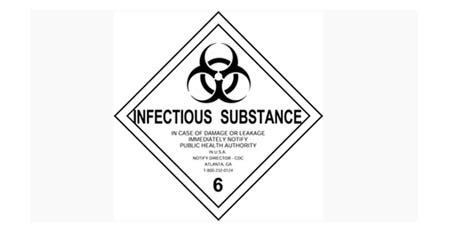Transporting Infectious Substances Overview

Transporting Infectious Substances
An infectious substance, including regulated medical waste, is regulated as a hazardous material under the U.S. Department of Transportation's (DOT's) Hazardous Materials Regulations (HMR; 49 C.F.R., Parts 171-180). PHMSA develops and enforces the HMR to ensure the safe transport of hazmat in interstate, intrastate and foreign commerce by aircraft, railcar, vessel, and motor vehicle.
The HMR apply to any material that DOT determines capable of posing an unreasonable risk to health, safety, and property when transported in commerce1, including infectious substances. An infectious substance must conform to all applicable HMR requirements when offered for transportation or transported by air, highway, rail, or water.
The HMR contain the requirements for classification, packaging, hazard communication, and, in some cases, security plans of infectious substances. Infectious substances generally fall into three classification categories:
- Category A – An infectious substance in a form capable of causing permanent disability or life-threatening or fatal disease in otherwise healthy humans or animals when exposure to it occurs.
- Category B – An infectious substance not in a form generally capable of causing permanent disability or life-threatening or fatal disease in otherwise healthy humans or animals when exposure to it occurs.
- Regulated Medical Waste – a waste or reusable material derived from the medical treatment of an animal or human.
Transporting Infectious Substances Safely Guidance
See DOT's Transporting Infectious Substances Safely Brochure for an important overview of the general transportation requirements for infectious substances.
Infectious Substance Oversight
Oversight responsibilities for infectious substances are shared by several Federal agencies that work together towards common goals. While the purview of the DOT is focused on the safe transportation of infectious substances, other organizations provide the expertise on classification, handling, workplace safety, waste disposal, and emergency or pandemic response.
CDC
The Centers for Disease Control and Prevention for Disease Control and Prevention (CDC), part of the Public Health Service of the U.S. Department of Health and Human Services, protects the public health of the nation by providing leadership and direction in the prevention and control of diseases and other preventable conditions, and responding to public health emergencies. The CDC conducts critical science and provides health information that protects our nation against expensive and dangerous health threats, and responds when they arise. The CDC is the authority for guidance on handling infectious substances before or after transportation.
OSHA
The Occupational Safety and Health Administration (OSHA), part of the U.S. Department of Labor, ensures safe and healthful working conditions for working men and women by setting and enforcing standards and by providing training, outreach, education, and assistance. OSHA has standards for bloodborne pathogens and personal protective equipment to protect workers from occupational exposure to infectious substances. As such, some OSHA standards are incorporated into certain DOT packaging requirements for regulated medical waste.
USDA
The U.S. Department of Agriculture (USDA) provides leadership on food, agriculture, natural resources, rural development, nutrition, and related issues based on public policy, the best available science, and effective management. Divisions within USDA and CDC form the Federal Select Agent Program (FSAP), which regulate the possession, use, and transfer of biological select agents and toxins that have the potential to pose a severe threat to public, animal or plant health, or to animal or plant products.
FEMA
The Federal Emergency Management Agency (FEMA), part of the U.S. Department of Homeland Security is tasked with helping people before, during, and after disasters. In the event of an infectious substance pandemic, FEMA works closely with the Department of Health and Human Services and state, local, tribal and territorial governments to execute a whole government response.
Special Topics
Monkeypox
For important information on the packaging of monkeypox contaminated waste, see the Notice of Enforcement Discretion Regarding Monkeypox Medical Waste. Also, note Appendix F-2 in Planning Guidance for Handling Category A Solid Waste.
Ebola
For important information on the packaging of Ebola contaminated waste, see Appendix F-1 of Planning Guidance for Handling Category A Solid Waste | PHMSA (dot.gov).
COVID-19
For important information on the COVID-19 pandemic, see the COVID-19 Information page.
Infectious Substance Special Permits
For important information on infectious substance special permits, including the special permit for Ebola contaminated waste, see the Infectious Substance Special Permits page.
